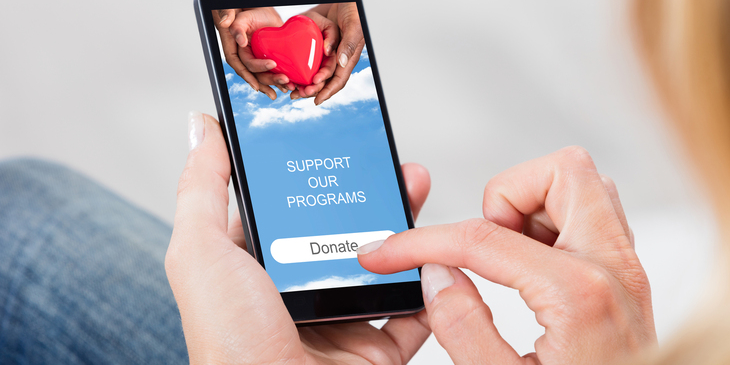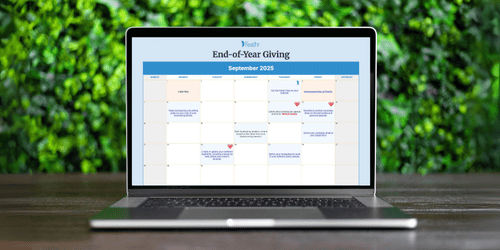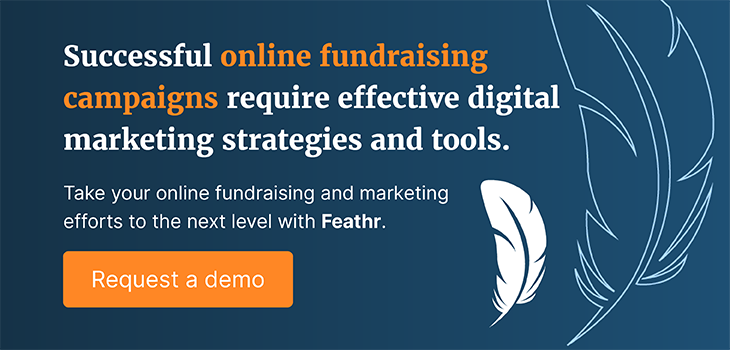
The complete guide to online fundraising (with 15 top ideas)
Think about all the things you do online: shopping for items you may or may not need, messaging loved ones, sharing artistic food photos, and watching heartwarming videos of unlikely animal friends. Whether for work or leisure time, most people spend a good portion of their day online.
That’s why your nonprofit needs a comprehensive online fundraising strategy. Among other online activities, nonprofit supporters are using online platforms to connect with their favorite organizations. The statistics reflect this — the past three years have seen a 42 percent increase in online giving. This trend will only continue as more nonprofits embrace virtual supporter engagement opportunities.
In this guide, we’ll cover everything you need to know to build a strong online fundraising plan — from choosing your marketing platforms to planning creative online fundraising campaigns. Here’s what to expect as you read on:
- Benefits of online fundraising.
- How to build an online fundraising strategy.
- Online fundraising ideas.
- Tracking online fundraising metrics.
You might be looking to revamp or build out your current fundraising strategy to make it more comprehensive. Or, this may be your first time tactically thinking about online fundraising, and you’re building a plan from scratch. No matter the situation, this guide can help you get on the right path and take on online fundraising more effectively. Let’s get started.
Benefits of online fundraising
Online fundraising benefits both nonprofits and nonprofit supporters, creating a more convenient process for donors and organizations alike.
Benefits for nonprofits
Online fundraising creates a convenient way for nonprofits to collect donations from their supporters. Specifically, adopting an online fundraising process allows your nonprofit to:
- Collect donations anywhere, at any time. You aren’t restricted to only collecting in-person donations at events or mailed-in donations. You can collect donations online 24/7.
- Gather funding quickly. Online donations are seamlessly deposited into your organization’s account, allowing you to access funding immediately.
- Connect with a wider audience. You can reach further audiences with an online campaign since you can contact anyone who has an internet connection. Online fundraising campaigns can even allow you to reach an international audience.
- Gather donor data. Easily collect donor data including donors’ names, contact information, demographics, and more using your online fundraising platforms. Then, you can save that data in your customer relationship management (CRM) system. Gathering insight into your supporter base can help you understand the best ways to market your organization to your target audience.
- Boost your fundraising ROI. Online fundraising campaigns tend to be less expensive than in-person fundraising initiatives since you don’t have to handle overhead costs like venue rentals.
Benefits for nonprofit donors
Nonprofit donors also benefit from the convenience of online fundraising. It allows them to:
- Give from anywhere. Donors can pull up your online fundraising page whenever they feel inspired to give and donate right away. Ensuring your page is mobile-optimized will make this process even easier.
- Take control over their contributions. When you choose robust fundraising software that offers donor portals and profiles, donors can set up recurring donations, change their donation amount, change their payment information, and view their donation history.
- Engage from the comfort of home. If you’re hosting an event or other virtual opportunity, your donors can participate and contribute to the campaign. Donors won’t have to leave their homes to get further involved with everything you have to offer.
How to build an online fundraising strategy
To reach your digital engagement goals, you’ll need a comprehensive online fundraising plan. If you’re looking to revamp or build your online fundraising strategy from the ground up, these steps will set you up for success.
1. Choose your online fundraising platforms and partners
The right online fundraising platforms and partners will allow you to manage your online fundraising campaigns, track donor data efficiently, and promote your fundraising initiatives to a wider audience. Choose these solutions wisely to set your organization up with tools that suit your unique needs.
Review the following fundraising platforms and partners and determine whether your organization needs to invest in any new solutions:
- Online donation platform. Your online donation platform allows you to build a digital donation page, process online donations, and expand into additional fundraising channels, like peer-to-peer fundraising or matching gifts. Typically, your primary online donation page will live as a standing page on your website as a source for your annual fund. However, robust platforms also provide specific pages to be used for individual campaigns.
- Supporter CRM. Your supporter CRM allows you to track donor and volunteer information like contact information, engagement history, and more. When your online donation platform and CRM integrate, you can automatically save information from new donors as a new profile in your database.
- Marketing tools. Your marketing tools will be critical in spreading the word about your online fundraising campaigns to new and existing audience members. These tools include website content management systems, digital ads, email marketing tools, and social media marketing platforms.
- Digital marketing partner. With all the innovative marketing strategies available today, digital marketing can quickly become confusing for nonprofits that are just starting to build their online outreach strategy. Partnering with a full-service digital marketing platform, like Feathr, can help you not only gain access to the marketing solutions you need but also help you make the most of those tools to reach your audience.
Before you pull out your credit card or start writing a check for all sorts of new software, really consider your nonprofit's current tech stack. How well do your current solutions fulfill your needs, and do you have any needs that are still unfulfilled? After asking these questions, you can truly consider if you require new solutions and determine which provider will best meet your unique needs.
2. Set a goal
Your online fundraising efforts should be purposeful and strategic. Set a goal for your online fundraising strategy to give your team something to work toward.
Assess your current situation and past online fundraising successes to set an achievable goal. If you’re just starting to consolidate your online fundraising efforts into a clear strategy, you shouldn’t set an outrageously high goal right away. However, if you’re revamping your existing strategy with new fundraising campaigns and events, consider setting a more ambitious goal to efficiently grow your funding.
Also, your goal should be specific and time-bound. For instance, you might set a goal to increase your online fundraising revenue by 20% in a year or engage at least 30 new online donors each month. A measurable, clear goal allows you to easily evaluate your progress over time and determine whether you’re on track.
3. Create an online donation page
Your online donation page will anchor your virtual fundraising efforts, providing a place for donors to contribute online from anywhere, at any time. While many specific campaigns will have dedicated donation pages, your online donation page is a constant opportunity for supporters to contribute to your annual fund.
Your online donation page should:
- Be simple and easy to fill out. Only ask for necessary information, such as donors’ contact information and payment details, to ensure donors can quickly fill out the form.
- Be branded to your organization. Your donation page should feature your organization’s logo, colors, and fonts. This reassures donors that they’re giving to your nonprofit and that their payment information will be kept safe.
- Provide suggested donation amounts. Offering suggested donation amounts can make it easier for donors to choose how much to give and may even encourage them to give more. For example, perhaps a donor clicked on your donation page intending to contribute $15, but then saw that your first suggested donation amount is $25. This could influence them to increase their donation amount to align with the type of donations you’re looking for.
- Include an option for recurring gifts. Include a checkbox that allows donors to turn their one-time gift into a recurring donation by signing up for your monthly giving program.
- Be mobile-friendly. The Blackbaud Institute found that nonprofit supporters made approximately 28 percent of online donations using mobile devices in 2021. Your online donation page should look just as good on mobile devices as it does on laptops and tablets. The page should be simple and easy to use on mobile, with large fonts and clear form fields.
- Highlight matching gift opportunities. Maximize online donations by sharing information about matching gift programs. In these corporate philanthropy programs, businesses match donations that their employees make to eligible nonprofits. Include a matching gift search tool somewhere within your online donation process, such as on the form itself or the donation confirmation page. This allows donors to easily research their matching gift eligibility and apply for a match.
- Be accessible. Your donation form should be accessible to everyone who wants to give, including supporters with disabilities. Design your page with the Web Content Accessibility Guidelines (WCAG) in mind. These guidelines are meant to help all kinds of organizations create accessible, inclusive web content. According to these guidelines, your online donation page should have features like sufficient color contrast between the foreground and background, straightforward navigation, and clearly labeled form fields.
No matter what type of online fundraiser you launch, be sure to use these suggestions consistently on your online fundraising platform. Consistency is key to ensure your supporters recognize your brand immediately and have a positive experience with your organization.
4. Select your fundraising ideas
To create a robust online fundraising strategy, you’ll need to fill your fundraising calendar with several virtual fundraising initiatives and campaigns. These may include everything from events and social media campaigns to email campaigns and matching gift drives. We’ll dive into more fundraising ideas later.
Ensure your calendar includes a marketing strategy for promoting your fundraising opportunities and thanking participants and donors.
5. Choose your marketing channels
As mentioned above, your online fundraising success relies on your nonprofit’s ability to get the word out about your campaigns. Choose the marketing channels you’ll use to advertise your nonprofit’s online initiatives. These channels might include:
- Social media (Facebook, Instagram, Twitter, TikTok, LinkedIn, etc.)
- Your website
- Text messages
- Google Ads
Consider your nonprofit’s audience when selecting your primary digital marketing channels. For instance, if your audience tends to be younger millennials and Gen Z, you might choose Instagram and TikTok as your principal marketing platforms. On the other hand, if your audience is Millennials and Gen X, you might consider using Facebook and email as your top outreach channels.
6. Create an appreciation strategy
Like any fundraising opportunity, you must thank the donors and participants who engage with your online fundraisers. Build a targeted appreciation strategy with the following components:
- Send thank-you emails, texts, and social media messages. Every time a donor gives online, send additional follow-up messages thanking them for their support. Personalize the messages with donors’ names and specific donation amounts.
- Show the impact of donors’ gifts. Provide updates on how you’re using donors’ contributions, whether it’s to purchase supplies for your animal shelter or fund your community garden expansion.
- Send additional ways to engage. Continue engaging with donors by offering multiple ways to get involved, such as volunteering, attending events, or participating in peer-to-peer fundraising.
Showing appreciation to online donors helps them feel valued by your organization, making it more likely that these donors will continue supporting your nonprofit over the long term.
With these six steps, you should be well on your way to developing a clear online fundraising strategy that aligns with your nonprofit’s overall growth goals.
15 online fundraising ideas
The following virtual fundraising campaign ideas will help you continuously engage with your supporters online all year round. Browse this list and consider which fundraising ideas will resonate most with your target audience, fit within your budget and capacity, and best support your online fundraising goals.
1. Social media campaign or challenge
Nonprofit fundraising statistics show that approximately 59 percent of people who engage with nonprofits on social media eventually donate to those organizations. By launching a social media campaign, you can connect with a wide variety of donors across different platforms and allow them to immediately give to your cause by sharing your online donation page.
You can carry out a social media campaign on any social media platform, including Facebook, Instagram, TikTok, and Twitter. For example, you can enroll in Instagram’s charitable giving program and add a donation button to your profile. Facebook fundraisers are particularly popular, as supporters can choose to launch a birthday fundraiser and ask their followers to contribute donations in lieu of birthday gifts.
Increase engagement with your social media campaigns by creating a unique challenge. For instance, you might encourage supporters to take a video of themselves completing a dance challenge, tag three friends in the post asking them to do the same, and share a link to your online donation page.
2. Peer-to-peer fundraising campaign
Peer-to-peer (P2P) fundraisers put your nonprofit’s supporters in the driver’s seat, allowing them to raise funds on behalf of your organization.
Here’s how the peer-to-peer fundraising process works:
- Your organization chooses a peer-to-peer fundraising platform.
- You use the platform to design a main peer-to-peer fundraising page that describes your fundraising goal and purpose.
- Your supporters use your software to also create personalized fundraising pages based on your main campaign page.
- Supporters share their fundraising pages with their family and friends and collect donations on your behalf.
- Your organization accepts donations and tracks progress using your P2P platform.
Support your P2P participants by offering a fundraising toolkit with advice on everything from designing their personal fundraising page effectively to best practices for sharing the page on social media. You should also interact with your supporters’ posts, thanking them for their involvement and encouraging them to reach their personal goals.
3. Crowdfunding
Crowdfunding is a type of online fundraising that seeks to gather many small donations from a vast audience. To launch a crowdfunding campaign, your organization will create a crowdfunding page on a platform like GoFundMe or Fundly. You’ll include your fundraising goal, a short description of your fundraising purpose, and a few visuals. Then, you’ll share the page widely online, using social media, email, and your website. Encourage your supporters and donors to also share this page to spread it as far as possible across the web.
These campaigns can be effective in helping you raise many donations in a short period. You can raise funds even more quickly by giving your crowdfunding campaign a hard deadline, adding a sense of urgency.
4. Matching gift drive
An estimated $4-$7 billion goes unclaimed in matching gifts annually, representing a significant untapped fundraising opportunity for most nonprofits. One of the most common reasons that matching gifts go unclaimed is a general lack of public awareness about these programs.
When launching a matching gift drive, you’ll share information about the positive impacts of matching gifts and details about how supporters can search for eligibility and apply for matches with their employers. Share a link to your matching gift database across your social media and email platforms to allow supporters to easily research their matching gift eligibility.
You can also partner with a business or individual donor to ask if they’d like to match all gifts made to your organization within a given time period, often a week or a month. For example, a health organization may partner with a company that matches contributions made during breast cancer awareness month.
5. Geofencing campaign
Mobile geofencing allows you to target prospective donors based on their location. Let’s say you want to connect with younger donors, particularly college students. You can use geofencing to send targeted ads to the mobile devices of everyone at a specific university campus.
You can also set up geofencing campaigns for events that took place in the past. For instance, if another organization hosted an event at the local park a couple of days ago, you can target that area with your geofencing campaign and reach all attendees with targeted ads.
Geofencing helps you reach a highly targeted audience that will be most receptive to your nonprofit’s outreach efforts. Increase engagement with your mobile ads even more by ensuring they’re well-designed and that they lead audience members to valuable, aesthetically-pleasing fundraising pages.
6. Google Ad campaign
Google Ads are the sponsored posts that appear at the top of Google search results pages. The Google Ad Grants program for nonprofits provides organizations with $10,000 per month to spend on these ads.
If your organization is accepted into the program, you can use the grant funds to bid on keywords relevant to your mission. For example, let’s say your nonprofit works to conserve and protect local wildlife in the Florida Everglades. You might choose to bid on the keyword “Florida Everglades conservation.” If your bid is accepted, your ad and a link to your website will appear at the top of the search results page for this valuable keyword.
Follow these best practices for a successful Google Ad campaign that drives website traffic:
- Choose relevant, high-volume keywords that receive a lot of search traffic. Use tools such as Moz or Google Keyword Planner to discover high-volume search topics.
- Create high-quality website content. The content you promote should be valuable for prospective supporters. Ensure your landing pages contain information about your organization, your fundraising and volunteer efforts, and how potential supporters can get involved.
- Track your campaign progress. Keep track of key performance indicators (KPIs) like your ad clickthrough rate and conversion rate (the rate at which visitors take the desired action, including donating or signing up to volunteer).
A Google Ad campaign can help you connect with an audience that’s more likely to engage with your ads since they’re already searching for relevant content. Plus, you can use that ad to link people directly to your fundraising page.
7. Email campaign
Email is a popular form of communication for all types of organizations, especially nonprofits. Studies have shown that nonprofits have the second-best industry open rate (after governmental organizations) at 25.2%.
An email campaign allows you to send more personalized messages to supporters using segmentation. Segmentation is the process of grouping subscribers based on shared characteristics. For instance, you might create segments of new donors, long-time donors, volunteers, and major donors. Then, you can send tailored messages relevant to each group’s interests.
Your email fundraising campaign should highlight why you’re raising money, your goal, and why donors should get involved. Use compelling images that represent your mission and the individuals you’re looking to help with your campaign. Include links to your online donation form so supporters can give right away.
8. Text-to-give
Text messages have some of the highest open rates of any outreach platform — 98%! — so using text outreach campaigns is a great way to get your message out there. A text-to-give campaign takes the idea of text message campaigns a step further, allowing supporters to respond and contribute directly through SMS messaging.
Here’s how the process works:
- Your organization partners with a text-to-give provider.
- You choose a concise, memorable keyword and receive a dedicated phone number.
- You share your keyword and number with supporters and encourage them to text your number.
- Supporters text you the keyword and receive a link to your online donation form, where they can immediately complete a mobile donation.
Include your text-to-give number in your social media profiles and posts, email updates, across your website, and even within your direct mail outreach to encourage more donors to use this giving channel.
9. Online shopping fundraiser
Nowadays, most people shop online for a variety of purchases, from birthday gifts and household supplies to new socks. With an online shopping fundraiser, your supporters can contribute to your organization while making these regular, everyday purchases.
To launch an online shopping fundraiser, follow these simple steps:
- Partner with an online shopping fundraiser partner like ShopRaise or Amazon Smile. These fundraising partners will facilitate your online shopping campaign by siphoning a portion of every purchase made during the campaign to your organization’s fundraising efforts.
- Promote your shopping fundraiser to your supporters. Ask supporters to download the browser extension or visit the link that will allow them to participate in your fundraising campaign as they shop. Promote your shopping fundraiser using all your digital marketing platforms, including social media and email.
That’s it! As supporters shop, they’ll generate passive fundraising for your organization, which can add up to a significant amount over time.
10. Virtual event
Virtual events can be a fun way to engage supporters in your fundraising efforts while providing them with an exciting experience. Here are a few fun virtual event ideas:
- Trivia night
- Movie night
- Livestreamed concert
- Virtual tour
- Comedy show
You can even send a survey to supporters asking them what types of virtual events they’d be most likely to attend. Be sure to sell tickets ahead of time to raise money through your event.
11. Online auction
For a charity auction, nonprofits gather a variety of items to place up for auction, including prize baskets, event tickets, and other valuables. Attendees bid on the items they want, and the prizes go to the highest bidders.
Virtual auctions work the same way — but they take place entirely online. And, just like an in-person auction, you can host a live or silent auction. For a live auction, you’ll need to invite supporters to your live-streamed event to submit their bids. For a silent auction, you can place your items up for auction online and keep the bidding open for a set period — like a week — to give supporters enough time to bid on the items they want.
Your corporate partners and other community relationships will be critical in helping you gather items for your auction. For instance, you can ask local home goods stores to donate furniture to your event, or a local winery to donate a wine-tasting experience.
12. Virtual race
Engaging supporters in a little friendly competition is an effective way to boost participation in your online fundraising campaigns. One way to do this is to host a 5K run or walk or bike race.
Racers will track their progress on an app (Strava or RunKeeper are good examples). Then, you can use the data from these apps to determine a race winner.
Raise money through your virtual race by requiring an entry fee. Participants can pay the fee themselves or use peer-to-peer fundraising to collect donations on your behalf ahead of the race.
Make sure to offer valuable prizes to winners like gift cards or prize baskets. You can also design t-shirts for your event to promote your organization’s brand and logo.
13. Virtual workshop or class
Help supporters learn something new by offering virtual classes and workshops. Request an entry fee to raise money through these events. Then, plan engaging, interesting, and interactive workshops with topics like:
- Cooking
- Knitting, sewing, or crocheting
- Painting
- Drawing
- Gardening
- Photoshop basics
- Graphic design basics
- Yoga
- Invasive plant identification
Reach out to local experts in your community to ask if they would donate their time to lead your virtual class. This might be a local pizzeria owner, yoga instructor, or artist. Experts who actually live in your community are more likely to want to help out and support a local charitable organization.
Send your instructors and participants emphatic appreciation messages after your class concludes to thank them for their support. You might even promote their business widely using your social media pages and emails to help them earn brand awareness and maybe even a few new customers. These actions increase the chances that your local experts will participate again if you host another event.
14. T-shirt and merchandise sale
A merchandise campaign accomplishes several goals at once. First, these types of campaigns help raise money for your cause. Second, they provide supporters with a comfortable and useful product in exchange for their monetary support. Finally, they allow your organization to grow awareness of your logo and brand as supporters wear and use your merchandise in public.
To launch a merchandise campaign, partner with a merchandise fundraising platform like Bonfire. Upload your design and promote your merchandise fundraising page to your supporters. Make sure the page includes a description of your fundraiser and your goal. Encourage supporters to share photos on social media featuring themselves wearing or using your merchandise to spread awareness of your campaign.
To help you develop your merchandise design and increase audience engagement, you might host a competition for supporters to submit their design ideas. Allow supporters to vote on their favorite design through a social media and email poll and choose the winner to use in your campaign.
15. Influencer campaign
You might think of an influencer as a stereotypical social media star who promotes hair care products and protein smoothies on Instagram. But there are all kinds of influencers for any industry you can think of. Consider partnering with a nonprofit influencer or an influencer relevant to your organization’s mission to launch a fundraising campaign with their help.
For example, let’s say your organization works to spread awareness of global human rights violations. By partnering with a prominent human rights activist or lawyer, you can spread awareness of your mission when they share your fundraiser with their audience.
You might recruit multiple influencers to help reach an even wider audience and gain more support for your fundraiser. Ask your influencers if they can share your organization’s online donation page and create videos promoting your campaign. In return, show your gratitude with a handwritten thank-you letter and plenty of appreciative social media posts.
Tracking online fundraising metrics
The final piece of a robust online fundraising strategy is creating a system for tracking your online fundraising progress. Select several important metrics or KPIs to track as you launch your campaigns to keep an eye on the progress made toward your goal.
Common online fundraising metrics nonprofits choose to track include:
- Online donation total. This one’s simple — it’s just the total monetary value of all of your online donations contributed in a specific time period. This can tell you how much of your overall fundraising strategy is coming from virtual sources.
- Average online donation amount. How much do supporters give online, on average? This metric can help you determine your suggested donation amounts.
- Online donor acquisition rate. How many new donors have you acquired online within a given time period? This can let you know the effectiveness of your new donor outreach.
- Online donor retention rate. How many online donors continue to give to your organization from one year to the next? A strong donor retention rate should be a top priority since it tends to be much more time- and cost-effective to retain recurring donors rather than constantly reach out to new donors.
- Donation page conversion rate. How many donation page visitors actually submit a donation? This metric can let you know whether you need to revamp your donation page by making it simpler or more compelling.
- Social media engagement rates (impressions, likes, comments, shares, etc.). How engaged are your social media followers with your content? Low engagement rates might mean it’s time to update your social media approach or focus your efforts on different platforms.
- Email open rate and clickthrough rate. Are your supporters engaging with your emails by opening them and clicking on the links to your website? If not, consider tweaking different aspects of your email strategy, such as your subject lines and visuals.
Gather these data points using your CRM, CMS, social media and email marketing platforms, and other online fundraising tools. Create regular reports for your team to review your fundraising progress, identify strengths and weaknesses, and adjust your strategy accordingly.
Wrapping up and additional resources
Hopefully, this guide helped you start thinking about online fundraising more strategically or plan new fundraising campaigns to round out your event calendar.
Remember, your online fundraisers will struggle to succeed if you can’t effectively reach a broad target audience. To help your fundraisers get the attention they deserve, Feathr offers a variety of digital marketing tools and services to increase your fundraising return on investment. Feathr’s services include:
- A digital advertising toolkit to help you manage multiple types of digital marketing, from geofencing to email mapping and donation abandonment to search keyword campaigns.
- Referral marketing solutions to create branded marketing collateral and make it easy for your partners to share your outreach materials.
- Helping you create new revenue streams by offering sponsored, omnichannel ads, sponsor dashboards, live campaign reports, and more.
Request a demo to learn more about how Feathr’s digital marketing services can generate greater awareness and engagement for your online fundraising efforts.
For more information on online fundraising and marketing, check out these additional resources:
- Digital Marketing for Nonprofits | A Comprehensive Guide. A strong digital marketing strategy can support your online fundraising goals. Use this guide to build a unique strategy for your organization.
- Nonprofit email marketing: Best practices for your strategy. Looking to improve your email marketing strategy? This guide offers best practices for increasing email engagement.
- 16+ Marketing Ideas for Nonprofits | Engage Your Supporters. Using innovative marketing strategies keeps your outreach efforts fresh and engaging. Review this post for 16 effective marketing ideas for your nonprofit.
You May Also Like
These Related Stories

Year-end giving ideas: 3 ways to boost EOY fundraising

The nonprofit fundraising calendar for maximizing EOY donations


